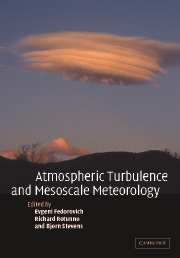Book contents
- Frontmatter
- Contents
- Preface
- Douglas K. Lilly: a biography
- Part I Atmospheric turbulence
- Part II Mesoscale meteorology
- 6 Model numerics for convective-storm simulation
- 7 Numerical prediction of thunderstorms: fourteen years later
- 8 Tropical cyclone energetics and structure
- 9 Mountain meteorology and regional climates
- 10 Dynamic processes contributing to the mesoscale spectrum of atmospheric motions
- Appendix A Douglas K. Lilly: positions, awards, and students
- Appendix B List of publications by Douglas K. Lilly
- Index
- Plate section
9 - Mountain meteorology and regional climates
Published online by Cambridge University Press: 04 August 2010
- Frontmatter
- Contents
- Preface
- Douglas K. Lilly: a biography
- Part I Atmospheric turbulence
- Part II Mesoscale meteorology
- 6 Model numerics for convective-storm simulation
- 7 Numerical prediction of thunderstorms: fourteen years later
- 8 Tropical cyclone energetics and structure
- 9 Mountain meteorology and regional climates
- 10 Dynamic processes contributing to the mesoscale spectrum of atmospheric motions
- Appendix A Douglas K. Lilly: positions, awards, and students
- Appendix B List of publications by Douglas K. Lilly
- Index
- Plate section
Summary
Introduction
The subject of mountain meteorology advanced quickly in the twentieth century. These advances can be organized into four broad themes: (A) local mountain climates and human adaptation; (B) airflow dynamics, the dynamic effect of terrain on winds; (C) the thermal effect of hills and slopes on local circulations; and (D) the influence of major mountain ranges on global circulations and climate. For the most part, researchers in these four fields have worked independently with their own tools, paradigms, meetings, and journals. This is especially true for theme (A), including subjects that are generally found in geography and in the agricultural, soil and social sciences (Peattie, 1936; Price, 1981). By contrast, themes (B), (C), and (D) lie clearly in the realm of atmospheric science. Ranked by the number of papers published, theme (B) has been the most active, perhaps because simple mathematical problems are most easily formulated in this area. This ease of formulation has brought together meteorologists and applied mathematicians to develop elegant theories of stationary mountain waves in two and three dimensions.
As in many areas of science, research in mountain meteorology has benefited from the interaction between different approaches. This synergy between different methods was evident in the 1970s and later, championed by Doug Lilly among others. Lilly used research aircraft to observe the spectacular, and still prototypical, 11 January 1972 severe downslope windstorm (Lilly and Zipser, 1972). He also used aircraft to gather statistics and understand the larger significance of wave momentum flux and turbulence (e.g., Lilly, 1972; Lilly and Kennedy, 1973; Lilly and Lester, 1974).
- Type
- Chapter
- Information
- Atmospheric Turbulence and Mesoscale MeteorologyScientific Research Inspired by Doug Lilly, pp. 193 - 222Publisher: Cambridge University PressPrint publication year: 2004
- 4
- Cited by



